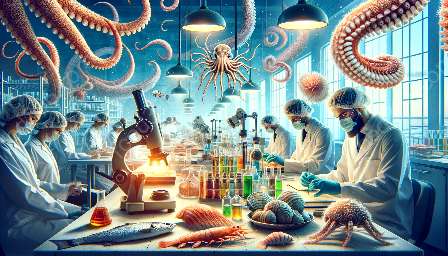Seafood quality control and assessment are crucial in ensuring the safety and quality of seafood products. This topic cluster explores the latest novel technologies in seafood science that are revolutionizing the way we monitor and maintain the quality of seafood. From advanced detection methods to innovative assessment tools, these technologies are enhancing seafood quality control in a real and sustainable way.
Advancements in Seafood Quality Control
With the increasing demand for seafood products worldwide, the need for effective quality control measures has become more pressing. Traditional methods of quality assessment, such as sensory evaluation and physicochemical analysis, are being complemented and enhanced by novel technologies that offer faster, more accurate, and more reliable results.
1. DNA Barcoding and Metabarcoding
DNA barcoding and metabarcoding are cutting-edge technologies that are revolutionizing the identification and authentication of seafood species. By analyzing the genetic markers present in seafood samples, these techniques can accurately identify the species and detect any potential mislabeling or fraud in seafood products. This not only ensures the authenticity of the seafood but also helps in traceability and preventing illegal trade.
2. Sensor-Based Technologies
Sensor-based technologies, such as electronic noses and tongues, are being increasingly utilized for rapid and non-destructive analysis of seafood quality. These electronic devices can detect volatile compounds and specific taste attributes, providing real-time and objective assessment of freshness and spoilage in seafood products. By leveraging sensor data, seafood producers and regulators can make informed decisions to maintain the quality and safety of their products.
3. Remote Sensing and Imaging
Remote sensing and imaging technologies, including hyperspectral imaging and infrared spectroscopy, are playing a vital role in monitoring the quality and safety of seafood along the supply chain. These non-invasive techniques can detect chemical and physical changes in seafood products, allowing for early identification of defects or contamination. By applying these technologies, seafood processors can take proactive measures to prevent quality issues and ensure consumer satisfaction.
Integration of Big Data and Artificial Intelligence
The integration of big data analytics and artificial intelligence (AI) is transforming the landscape of seafood quality control and assessment. By leveraging vast amounts of data generated from various sources, including production, processing, and distribution, AI algorithms can identify patterns and predict potential risks related to seafood quality. This proactive approach enables stakeholders to implement targeted interventions and minimize the likelihood of quality and safety incidents.
1. Predictive Modeling and Risk Assessment
Predictive modeling techniques, powered by AI, can analyze historical data and environmental factors to predict the shelf life and spoilage of seafood products. By assessing the risk of quality deterioration, seafood producers and retailers can optimize their storage and transportation processes, thereby reducing product losses and ensuring superior quality upon consumption.
2. Blockchain Technology for Traceability
Blockchain technology is being harnessed to establish transparent and secure traceability systems in the seafood industry. By recording transactional data in an immutable and decentralized manner, blockchain enables end-to-end traceability of seafood products, from the point of harvest to the consumer's plate. This not only enhances consumer confidence but also facilitates rapid identification of the source of quality concerns, allowing for targeted recalls and quality control measures.
Next-Generation Quality Monitoring
As the demand for high-quality seafood continues to grow, the development of next-generation tools for quality monitoring is imperative. These advanced technologies offer unique capabilities for real-time assessment and assurance of seafood quality, promoting sustainability and consumer satisfaction.
1. Biosensors and Nanotechnology
Biosensors and nanotechnology are driving innovation in the development of compact and sensitive devices for seafood quality assessment. These miniaturized tools can detect specific biological markers and contaminants in seafood, providing rapid and on-site analysis. By harnessing the power of nanomaterials and bio-recognition elements, biosensors are revolutionizing the detection of pathogens and toxins, thereby mitigating risks associated with foodborne illnesses.
2. Virtual Reality (VR) and Augmented Reality (AR)
Virtual reality and augmented reality are being explored as immersive technologies for training and simulation in seafood quality control. By creating realistic and interactive environments, VR and AR enable professionals to undergo virtual hands-on experiences in identifying quality attributes and conducting assessments. These technologies have the potential to enhance the proficiency and accuracy of seafood inspection and quality control personnel, contributing to strengthened regulatory compliance and overall product integrity.
3. Laser-Based Spectroscopy and Imaging
Laser-based spectroscopy and imaging techniques offer high precision and sensitivity in analyzing the chemical composition and structural characteristics of seafood. By emitting light and capturing the reflected signals, these non-destructive methods can reveal valuable information about freshness, nutrient content, and potential contaminants in seafood samples. With advancements in laser technology, these tools are becoming increasingly accessible and cost-effective, empowering seafood stakeholders with comprehensive insights into product quality.
Conclusion
The ongoing advancements in novel technologies for seafood quality control are reshaping the landscape of seafood science and industry. By embracing these technologies, stakeholders can ensure the production of safe, authentic, and high-quality seafood products, meeting the diverse needs of consumers and upholding the sustainability of marine resources. As research and innovation continue to drive the development of cutting-edge tools and methodologies, the future of seafood quality control holds immense promise for fostering confidence, transparency, and excellence in the global seafood supply chain.

